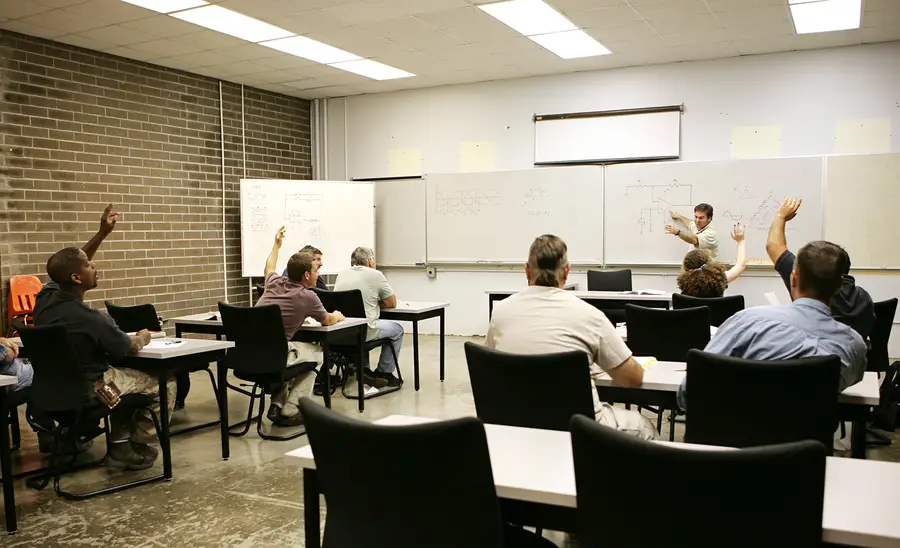Pamela K. Lattimore, of RTI’s Division for Applied Justice Research, testified in June 2021 before the U.S. House of Representatives Committee on Education and Labor at a reauthorization hearing for the Workforce Innovation and Opportunity Act. This Insights post is based on her testimony.
Education is a force for transformation. Those of us who have benefited from it can easily point to the educational experiences that helped make us who we are.
For the millions of individuals involved in the justice system in the United States, a lack of education and the opportunities it brings create a major obstacle to a positive, productive future.
Education and workforce reentry programs offer a solution. These programs, conducted within the justice system, provide transformative opportunities that can lead to a better life for the individuals and their families and safer communities as criminal activity is reduced or prevented.
We have decades of combined experience studying the justice system, including reentry education programs. Congress has wisely chosen to fund many of these programs over the years, providing participants with new opportunities, and giving researchers a chance to observe the programs’ effectiveness. We know these programs are cost-effective, saving taxpayer dollars as the participants are less likely to commit new crimes and return to the system. We also know some of the characteristics of the best reentry education programs.
Based on our research and observations, here are our top 5 recommendations for programs and interventions for justice-involved individuals:
Stackable credentials lead to living-wage jobs with the opportunity for advancement
Education services offered by correctional facilities often are disconnected from community-based education programs and meaningful employment and career advancement opportunities. We recommend that correctional education programming be geared toward preparing individuals for living-wage jobs with benefits and the possibility for advancement.
Coordinating with community colleges is key, so that individuals can seamlessly continue their studies after their release, or vice versa. Prisons to Professionals is one example of a program that has found success matching incarcerated people with pathways to postsecondary education. We also recommend offering training in career fields experiencing labor shortages, including construction, commercial driving, and information technology.
The value of ‘earning while learning’ in the justice system
Most individuals in prisons and jails are eager to participate in programs during incarceration, but after they are released, their participation tends to drop off. We believe financial support is the best way of encouraging individuals to complete their programs. Many justice-involved individuals owe fees or fines, or have child care, child support, or transportation expenses. Financial support during their training keeps them from taking dead-end jobs. It is a long-term investment that benefits society as a whole.
Evaluations should allow more time for reentry programs to show results
Our experience evaluating reentry programs shows that it takes time for these programs to reach their peak level of effectiveness. Two- or three-year grants are too short. Programs need more time to not only address individuals’ needs, but also refine and strengthen their approach.
The appropriate questions to ask about a program’s educational components are:
- Did the education result in increased skills and knowledge?
- Did the increased skills and knowledge lead to a job related to the education that was sufficiently meaningful to encourage retention?
- Did a meaningful job result in desistance from a criminal lifestyle?
Only after we affirm that an intervention achieves its primary objective is it appropriate to ask about the other expected outcomes—living-wage employment with opportunities for career advancement, and if that is achieved, reductions in criminal recidivism. If the learning achievement is lacking or insufficient, the program should be strengthened—not necessarily abandoned—and new data should be collected to see if the revised program results in increased and retained learning.
Further reentry education research is essential
The study of reentry education programs has great potential. We need to know more about the types of programs that work, for whom specific programs are most effective, and how much education is needed to improve the chances for meaningful employment. We also need to understand how education and employment skills fit within the constellation of overall needs of justice-involved individuals, including substance abuse, mental health treatment, housing, transportation, and childcare. In particular, there has been little research that seeks to determine how the order in which individuals are offered programs to address multiple needs affects outcomes.
Focus on more than recidivism
After a long career studying the American justice system, we often find that the only question we are asked about our findings concerns recidivism. Reducing recidivism is important. However, this exclusive focus on recidivism at the expense of other indicators undermines the ultimate goal.
Except for some criminal thinking and cognitive behavioral programs, most programming implicitly assumes a path that includes intermediate changes that are required to reduce recidivism. High quality education and employment programs must first increase knowledge and skills, and these new talents must lead to better employment. Only then should we assess the impact on recidivism.
We can also assess other factors, such as learning gains, program completion, credentials earned, enrollment in further education, quality of employment, wages earned, and career advancement. These measures also make a difference in the lives of people participating in reentry education, and are worthy of consideration.



